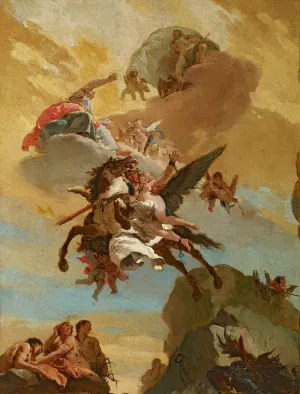Tiepolo in Milan: The Lost Frescoes of Palazzo Archinto
Preparatory Works Reunited for the First Time in Their History
Next spring, The Frick Collection will reunite a series of preparatory paintings and drawings related to Giambattista Tiepolo’s (1696–1770) first significant project outside of Venice, a series of ceiling frescoes for Palazzo Archinto in Milan, executed between 1730 and 1731. The paintings were commissioned by Count Carlo Archinto (1670–1732), whose family distinguished itself in the seventeenth and eighteenth centuries under both the Spanish and imperial rulers of Milan. Tragically, the Palazzo was bombed during World War II, and its interior was completely destroyed. The only record of the finished frescoes in situ is a series of black and white photographs taken between 1897 and the late 1930s. Tiepolo in Milan: The Lost Frescoes of Palazzo Archinto will present approximately fifty objects from collections in the United States and Europe to tell the story of this important commission. It will feature five surviving preparatory paintings and drawings by the artist, among them the Frick’s oil sketch Perseus and Andromeda. As the Frick does not loan works that were purchased by the institution’s founder, the New York City museum is the only place where these paintings and drawings can be seen together. Other complementary drawings and prints by Tiepolo will be on view, as well as several books of illustrations by the artist that were commissioned by Filippo Argelati, the Archinto family librarian and a noted intellectual of the day. The exhibition is curated by Xavier F. Salomon, the Frick’s Peter Jay Sharp Chief Curator, with Andrea Tomezzoli, Professor at the University of Padua, and Denis Ton, Curator of the Musei Civici in Belluno.
Comments Salomon, “Tiepolo in Milan is the latest in a series of exhibitions at the Frick to focus on outstanding Italian artists. It follows in the footsteps of Canova’s George Washington, which brought to life Canova’s lost eighteenth-century masterpiece, his only American commission. By bringing together the preparatory works for these great masterpieces, we are able to tell incredible stories that are in danger of being forgotten.”
Of the preparatory works that survive from the Archinto commission, three painted sketches on canvas provide the most important evidence about the lost frescoes: Triumph of Arts and Sciences (Museu Nacional de Arte Antiga, Lisbon), Apollo and Phaëton (Los Angeles County Museum of Art), and the Frick’s Perseus and Andromeda. These works will be joined by the only known drawings by Tiepolo related to the frescoes in Milan: one from the Civico Museo Sartorio in Trieste, and the second from the Finnish National Gallery, Sinebrychoff Art Museum in Helsinki. Additionally, the show will feature two Tiepolo oil sketches—from the Akademie der bildenden Künste in Vienna and The Bowes Museum in Barnard Castle, England— that represent the myth of Phaëton and have been connected by scholars to the Archinto cycle.
The Archinto family, one of the most prominent in Milan, was celebrated for its intellectual pursuits. Carlo, in particular, was known for his interest in the arts and sciences, specifically mathematics and philosophy, and had assembled the most important private library in the city. The decoration of his palace and Tiepolo’s frescoes were very much part of the Archinto family’s intellectual aspirations and interests. The additional ceilings painted for the commission were Juno, Fortune, and Venus and Nobility. Together, these five mythological and allegorical scenes decorated several of the grandest rooms of the palace and were probably executed to celebrate the wedding of Carlo’s son Filippo and Giulia Borromeo, which took place in April 1731. The frescoes were praised by a number of sources soon after they were painted, including Serviliano Latuada, who remarked on their beauty in his 1737 guidebook to Milan, Descrizione di Milano.
An exhibition catalogue published by The Frick Collection in association with Paul Holberton Publishing will accompany the show. Included will be essays about Tiepolo’s work in Palazzo Archinto (Xavier F. Salomon), the architectural history of the palace (Alessandra Kluzer), the role of the Archinto frescoes in Tiepolo’s career (Andrea Tomezzoli), and the intellectual world of the Archinto family (Denis Ton). Major support for the exhibition is provided by an anonymous gift in memory of Melvin R. Seiden and by Margot and Jerry Bogert. Additional funding is generously provided by the David L. Klein, Jr. Foundation, Julie and David Tobey, an anonymous gift in memory of Charles Ryskamp, Dr. Tai-Heng Cheng and Cole Harrell, Mr. and Mrs. Hubert L. Goldschmidt, and The Krugman Family Foundation.

